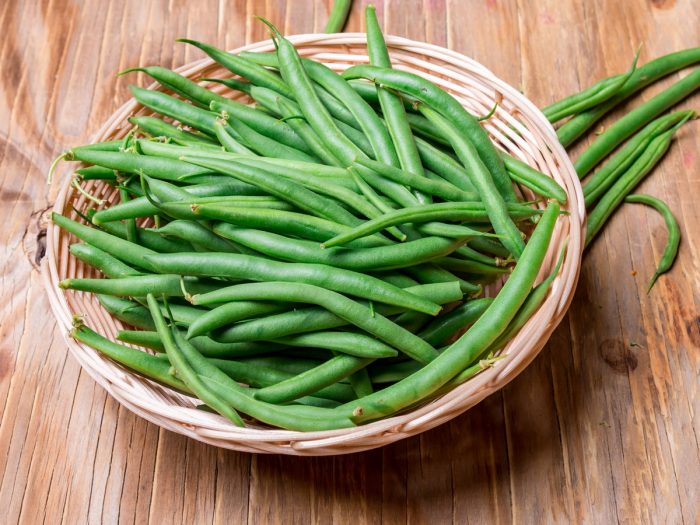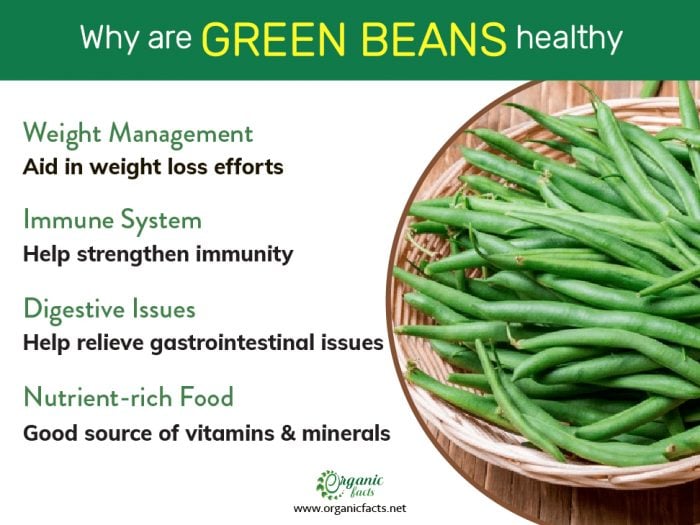Green beans may seem like a typical staple at nightly dinners. However, what you may not be aware of are the health benefits that green beans have to offer. They may appear to reduce the risk of heart diseases, help manage diabetes, provide a boost to the immune system, and contribute to the elimination of harmful free radicals.
These nutrient-packed beans are an excellent low-calorie dietary choice that is great for possibly acquiring vitamins and minerals without adding any unwanted pounds.
What are Green Beans?
Green beans are members of the common bean family, Phaseolus vulgaris, and are a popular part of diets around the world. There are slight variations in the bean – they can be different shapes, colors (even purple), and by different names, including French beans, fine beans, string beans, or even squeaky beans, depending on the region of the world. There are approximately 150 varieties of green beans throughout the world! Despite the variable appearance of the beans, their nutritional content and health benefits remain similar.
Green beans are a versatile vegetable that grows in many different climates. This has made them popular and globally recognized food. Although popularized in many American and European dishes, they are widely cultivated across Asia and Africa as well. They appear in a wide array of cultural dishes and offer health benefits to people all around the world. They can be cooked in a variety of forms like roasted green beans, sauteed green beans, pickled green beans, and so on!
Types of Beans
Green beans fall into two categories: “pole beans” and “bush beans”.
- Pole beans tend to climb like vines, require support systems to grow properly, and are slightly slower in reaching maturity.
- Bush beans are lower to the ground, require no support, and have faster developmental rates, meaning that some farmers and growers can have more than one crop of bush beans in a single season.
- It is important to remember that green beans are unripe or immature foods, so some people prefer to soak or cook the beans before eating them. However, there are no proven harmful effects of eating raw green beans. Here, you can find out whether green beans are legumes or vegetables. [1]
While many “common beans” share similar attributes, they are unique and are chosen according to the individual properties that each of the beans offers. Green beans are a favorite choice in many cultures for the variety of vitamins, nutrients, and beneficial properties they contain.
| Serving Size : | |
|---|---|
| Nutrient | Value |
| Water [g] | 90.32 |
| Energy | 31 |
| Energy [kJ] | 131 |
| Protein [g] | 1.83 |
| Total lipid (fat) [g] | 0.22 |
| Ash [g] | 0.66 |
| Carbohydrate, by difference [g] | 6.97 |
| Fiber, total dietary [g] | 2.7 |
| Sugars, total including NLEA [g] | 3.26 |
| Sucrose [g] | 0.36 |
| Glucose (dextrose) [g] | 1.51 |
| Fructose [g] | 1.39 |
| Starch [g] | 0.88 |
| Calcium, Ca [mg] | 37 |
| Iron, Fe [mg] | 1.03 |
| Magnesium, Mg [mg] | 25 |
| Phosphorus, P [mg] | 38 |
| Potassium, K [mg] | 211 |
| Sodium, Na [mg] | 6 |
| Zinc, Zn [mg] | 0.24 |
| Copper, Cu [mg] | 0.07 |
| Manganese, Mn [mg] | 0.22 |
| Selenium, Se [µg] | 0.6 |
| Fluoride, F [µg] | 19 |
| Vitamin C, total ascorbic acid [mg] | 12.2 |
| Thiamin [mg] | 0.08 |
| Riboflavin [mg] | 0.1 |
| Niacin [mg] | 0.73 |
| Pantothenic acid [mg] | 0.23 |
| Vitamin B-6 [mg] | 0.14 |
| Folate, total [µg] | 33 |
| Folate, food [µg] | 33 |
| Folate, DFE [µg] | 33 |
| Choline, total [mg] | 15.3 |
| Betaine [mg] | 0.1 |
| Vitamin A, RAE [µg] | 35 |
| Carotene, beta [µg] | 379 |
| Carotene, alpha [µg] | 69 |
| Vitamin A, IU [IU] | 690 |
| Lutein + zeaxanthin [µg] | 640 |
| Vitamin E (alpha-tocopherol) [mg] | 0.41 |
| Vitamin K (phylloquinone) [µg] | 43 |
| Fatty acids, total saturated [g] | 0.05 |
| 16:0 [g] | 0.04 |
| 18:0 [g] | 0.01 |
| Fatty acids, total monounsaturated [g] | 0.01 |
| 18:1 [g] | 0.01 |
| Fatty acids, total polyunsaturated [g] | 0.11 |
| 18:2 [g] | 0.04 |
| 18:3 [g] | 0.07 |
| Tryptophan [g] | 0.02 |
| Threonine [g] | 0.08 |
| Isoleucine [g] | 0.07 |
| Leucine [g] | 0.11 |
| Lysine [g] | 0.09 |
| Methionine [g] | 0.02 |
| Cystine [g] | 0.02 |
| Phenylalanine [g] | 0.07 |
| Tyrosine [g] | 0.04 |
| Valine [g] | 0.09 |
| Arginine [g] | 0.07 |
| Histidine [g] | 0.03 |
| Alanine [g] | 0.08 |
| Aspartic acid [g] | 0.26 |
| Glutamic acid [g] | 0.19 |
| Glycine [g] | 0.07 |
| Proline [g] | 0.07 |
| Serine [g] | 0.1 |
| Sources include : USDA [2] | |
Green Beans Nutrition
According to FoodData Central, these delicious and crunchy beans can be low in calories and fat and may contain no cholesterol. The fiber content can be high, and these beans may also provide some of the daily protein requirements. They might also act as an easy source for acquiring vitamins like vitamins A, C, K, B6, and folic acid. In terms of minerals, green beans can be a good source of calcium, silicon, iron, manganese, potassium, and copper. [3]
Health Benefits of Green Beans
In addition to being versatile and delicious in many culinary preparations, green beans can provide a wealth of nutrients. Let’s look at the wide range of benefits in detail.
May Reduce Heart Diseases
Green beans may help reduce the risk of heart diseases due to their high levels of flavonoids. Flavonoids are polyphenolic antioxidants commonly found in fruits and vegetables. Test subjects with high flavonoid levels experienced anti-thrombotic results, preventing blood clots in the arteries and veins. Cardiovascular diseases, heart attacks, and strokes are commonly caused by thrombotic activity, so the incorporation of green beans in your diet may help mitigate some of these conditions. [4]

Green beans are an excellent low-calorie dietary choice for a healthy eating regime. Photo Credit: Shutterstock
May Manage Diabetes
A study on plant foods at the Central Food Technological Research Institute in India claims that green beans are one of the vegetables that can be known to have a definitive hypoglycemic influence on patients with diabetes. Diabetes is a condition that requires constant maintenance of blood sugar levels at a normal level so the body can perform necessary tasks. Natural regulators of diabetes are rare, so the connection of green beans and similar plants to the control or early prevention of diabetes is great news for many to manage and prevent the disease. [5]
May Boost Immunity
The possible presence of various immune system-boosting antioxidants in green beans is well known. Antioxidants are beneficial compounds in our body that seek out dangerous free radicals, may intend to eliminate them from our system before they can cause illness or tissue damage.
Green beans can be a good source of carotenoids and flavonoids, with carotenoids found in green beans containing antioxidants like beta carotene and lutein. Flavonoids contain basic antioxidants like quercetin and kaempferol, but also the ones like catechin and epicatechin. Catechin can be associated with reducing the severity of strokes. [6] [7]
May Regulate Digestive Function
The high fiber content of green beans can also positively impact the digestive system, easing the digestive process and promoting bowel movements, which may decrease the stress on the bowel walls.
By keeping enough fiber in our diets, we can ease certain digestive issues like constipation, hemorrhoids, ulcers, and acid reflux disease. These conditions can range from mild irritants to potentially life-threatening, and the amount of fiber we consume is a key element in their prevention. In a normal 110 grams serving of green beans, you may gain 15 percent of the daily recommended amount of fiber. They are one of the few vegetables that can ease the functioning of your stomach properly. [8]

Green beans may help reduce the risk of heart diseases due to their high levels of flavonoids.
Fertility & Pregnancy
According to a study in the Harvard Medical School, the consumption of healthy foods like green beans and pumpkins may increase fertility as these foods are a powerhouse of various nutrients. [9]
Green beans can be a great source of folic acid, which may play a key role in several internal processes, but none are more important than protecting infants in the womb. Folic acid levels in a woman’s body are vital to the normal and healthy development of the fetus. Green beans may provide an easy and delicious way to keep folic acid levels high and ensure a healthy and happy baby. [10] [11] [12]
Other benefits:
- Eye care: Carotenoids found in green beans may prevent macular degeneration and can also prevent any stress to the inner workings of the eye.
- Improve bone health: Green beans might be abundant in vitamin K, calcium, and silicone. These vitamins and minerals can be vital in preventing bone deterioration and osteoporosis.
Green Beans Side Effects
Green beans are one of those foods with extremely few risk factors. A few risk factors include the following:
- Phytates: Phytic acid is present in green beans, and can contribute to nutrient deficiencies when consumed in excess. Phytic acid binds with calcium, zinc, and other important minerals, and prevents them from being absorbed by the body. Although the phytate levels in green beans are relatively low, if you suffer from other conditions that cause a mineral deficiency, the addition of more phytic acid may not be the best choice for you. Also, cooking or soaking beans can significantly reduce amounts of phytic acid, so just avoid eating them raw if you are concerned about phytate levels. [13]
- Lectins: Lectins are carb-binding proteins found in a variety of foods, but are notoriously present in beans. Green beans happen to have lower levels than others, but it is still there, and too much lectin can cause the proteins to bind up the intestinal system and cause a variety of digestive problems. Cooking at high temperatures or prolonged soaking in water can reduce the lectin content of most foods. [14]
- Allergies: As with any food, some people are allergic to green beans and other legumes, so make sure to consult with a doctor about how to treat your food allergies.
